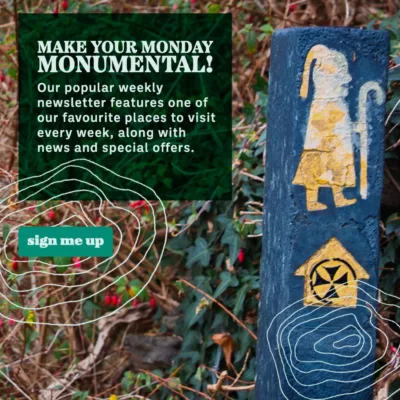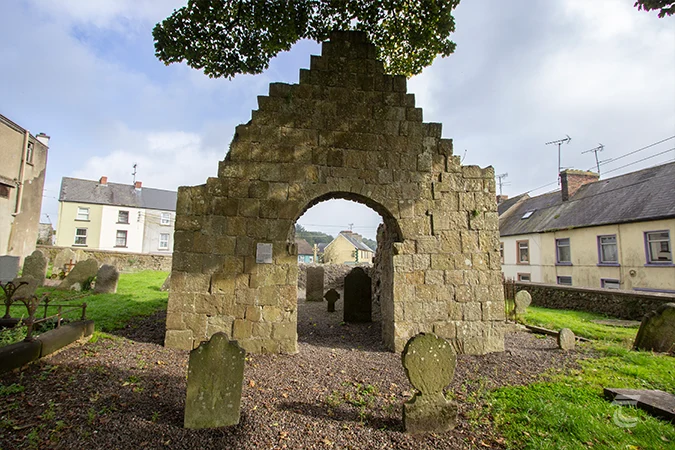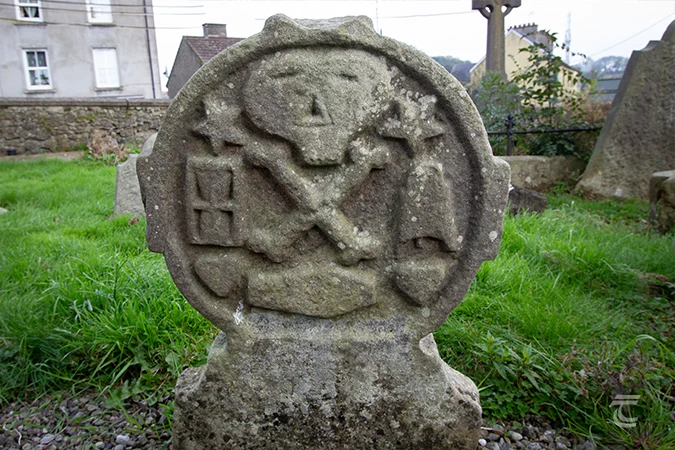Clones
The market town of Clones, (pronounced clow ness and deriving from the Irish ‘Cluain-Eois‘ meaning ‘the Meadow of Eos’), is located in the west of County Monaghan, near the border with counties Fermanagh and Cavan. The town developed from an early monastery founded by St Tighearnach in the 6th century. The monastery became an Augustinian foundation after around 1140. Though much of the original monastery has been lost, echoes of Clones’ early roots can still be discovered in the town. One of the most prominent reminders of the town’s monastic past can be seen in the early medieval high cross, that stands in the ‘Diamond’ at the centre of the town. This cross is unusual in that it is actually fragments of two different 10th-century crosses mounted together, hence its distinctive look. The shaft that comprises the lower section is intricately carved with biblical scenes on its faces and geometric ornament on its sides. Though weathered, some of the depictions can still be discerned: on the shaft, Old Testament scenes adorn the western face, and New Testament on the eastern face. The head of the cross depicts more Old Testament scenes on the western side, with the Crucifixion on the eastern face.
In the old graveyard there is more evidence of the early monastery in the 23-metre (75-ft) tall round tower that stands proudly amidst the tombs. The round tower is thought to date to some time between the 10th and 12th centuries, though it is comparatively rather roughly constructed of uncoursed rubble rather than dressed stone. The base of the tower was investigated by antiquarians in the 19th century, as described by Wakeman, who recounts that it was dug by a Mr Edmund Getty of Belfast and his companions. They reportedly encountered a significant amount of human remains which were interpreted as having been deposited as bones rather than as full bodies. This is similar to the secondary use of the round tower at Rathmichael in Dublin, which became known as the ‘Skull House’ as it was used to deposit disarticulated human remains in recent centuries.
An unusual gabled stone shrine, shaped like a miniature church, stands nearby. It is carved from a single block of sandstone, with a very worn figure wearing a mitre on the eastern ‘gable’. This shrine may have originally housed the relics of St Tighearnach himself, though it dates to at least 500 years after his time. It was moved to its current position in the 18th century to cover a burial vault. The graveyard has many fascinating tombstones from the 17th, 18th and 19th centuries. Many bear a skull on the reverse, known as a memento mori, a grisly reminder of our mortality and fleeting time on Earth.
For practical information about visiting this site Click Here
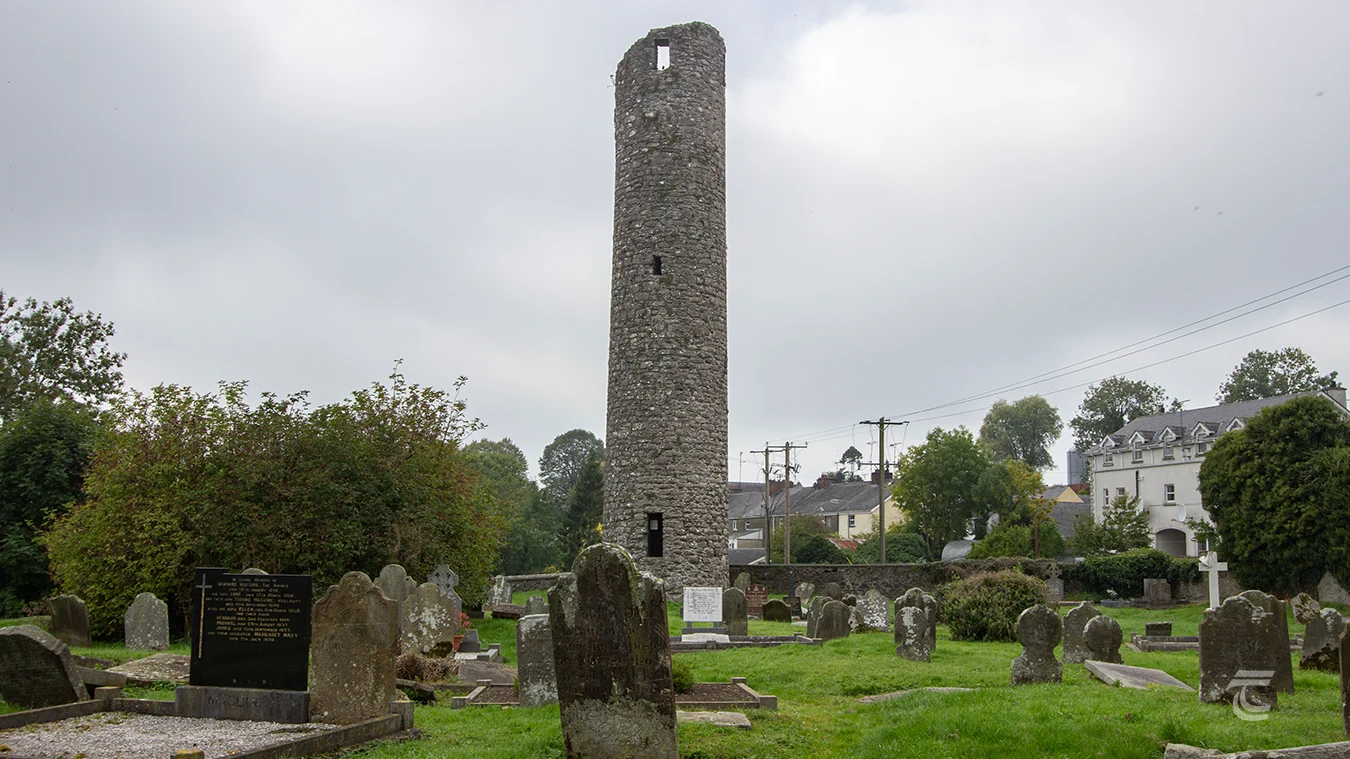
Clones Round Tower and Old Graveyard • Monaghan
The History and Folklore of Clones
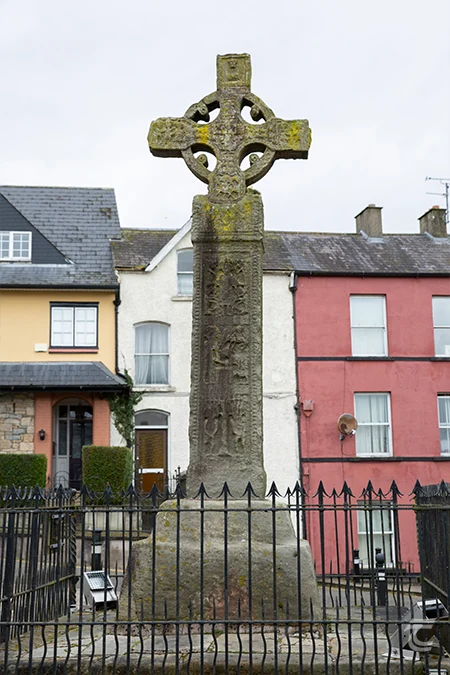
The High Cross in the Diamond • Clones, Monaghan
The remains of another medieval church, known as the ‘Wee Abbey’, can be found across the road from the old graveyard. This is likely to be the nave of a stone church, dating to around the 12th century. It was part of the foundation of the Augustinian Canons that began in around c.1140, and it is believed that it was originally dedicated to saints Peter and Paul.
More evidence of Clones’s medieval past is to be found in the large motte-and-bailey castle on the western side of the town (unfortunately situated on private land and inaccessible). According to the Annals of the Four Masters, the motte was established in 1211:
‘In 1211 the castle of Clones was erected by the English and the English bishop, and they made a predatory incursion into Tyrone; but Hugh O’Neill overtook them, and routed and slaughtered them, and slew amongst others, Myler, the son of Robert.’
The castle was possibly abandoned after this attack, as there are no further historical mentions of it. Interestingly, this large mound may have more ancient origins than simply being another motte and bailey. Writing in 1875, the antiquarian Wakeman recorded that he had heard of a subterranean passageway, though he himself had not seen it. A number of mottes typically ascribed as being of Anglo-Norman origin have begun to be reappraised in recent years, such as Gallowshill in Dungarvan, Waterford. Archaeologists such as Professor Tadhg O’Keeffe have speculated that they may in fact be an Irish version of the sort of earthen castles found in France in the 11th century, built by outwardly-looking Irish kings who were engaged with what was happening on the continent and elsewhere. As the motte at Clones is described as having external banks and ditches, and a subterranean passageway (a possible souterrain?), could this be another example of an early Irish motte, that was then reused by the pragmatic Anglo Normans? Only further archaeological investigation can provide the answer. You can hear Professor Tadhg O’Keeffe discuss the origins of Irish castles in this episode of Amplify Archaeology Podcast.

The High Cross in the Diamond • Clones, Monaghan
In recent years, a 17th century fortified house known as Clones Castle was rediscovered, hidden in plain sight (and swallowed by ivy and Georgian buildings) on Castle Street in the town, there was a clue there somewhere! You can read about its rediscovery here.
There’s a number of other references to Clones in the ever-excellent Schools’ Folklore Collection. One story describes how the famous Daniel O’Connell arranged for one of his ‘Monster-Meetings’ to be held in the old graveyard in 1845. O’Connell himself could not attend, but he was represented by an ally of his, by the name of Lawless. As the meeting was underway, the local protestants held their own meeting in the Diamond in the town, where they spoke vehemently against O’Connell and his ideas of Catholic Emancipation. As the Catholics passed by the protestant meeting following the end of Lawless’s speech, the two sides began fighting and throwing stones at each other. One man named MacCafrey was said to have been killed in the fight.
Another tale concerns the motte, or the Old Fort. In the 19th century, an old piper made a bet that he could prove that there was a tunnel that ran from the fort. The piper took up his pipes, and entered the mouth of a tunnel in a yard owned by men called Parker and McGomery. The piper played a tune on his pipes as he made his way into the tunnel, and people heard the tune all the way up to the steps of the protestant church. Then the music died away. Neither the piper, nor his pipes were ever seen again.
Also included in the Schools’ Record is this charming song, called Clones Fair.
‘Where ever you in Clones or did you see the fair?
The girls they are so handsome and the boys the devil may care.
When they meet in Fermanagh street they will give each other the wink
Good day, says Paddy to Biddy, won’t you come in and have a drink?’
Upper left: the ‘Wee Abbey’ • Lower left: memento mori on an 18th century grave • Right: the tomb shrine and round tower
Top: the Wee Abbey • Middle:the tomb shrine and round tower • Bottom: memento mori on an 18th century grave
Clones Round Tower and High Cross Visitor Information
A visit to the town of Clones offers a glimpse into Monaghan’s storied past.
